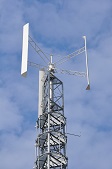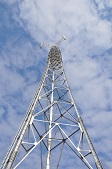Range:
· On - Grid lub Off - Grid.
· Height - 30 - 60m.
· Power of the wind turbine - 6-55kW (power also depends on the annual average wind speed at a given location).
· Mounting platforms 1-3.
Additional energy options:
· Photovoltaic panels - 10-50kW.
· Emergency Generator - 2-30kW.
· Generator based on fuel from recycling.
Components
The components of the basic version of the product:
1. Mast
The range of structures with different heights and energy parameters was used here. GETS is a tower with unique mechanical properties capable of fulfilling the conditions of capacity, in particular rigidity, ensuring resistance to the force of tension caused by the wind pressure on the blades of a wind turbine and emerging dynamic loads resulting from the operation of the turbine, while maintaining economically reasonable weight of the structure. Moreover, it is a telecommunication tower with a unique, frame structure, adapted to fulfil the role of power system carrier with vertical rotation wind turbine, antenna of electronic communications systems and surveillance cameras and measurement sensors.
The structure has been designed in such a way so as to meet all the requirements of the project norms in terms of load capacity and rigidity, as well as requirements arising from the need to ensure proper operation of antenna systems and monitoring installations. There has also been applied an innovative solution of cable routing - a unique system of cable routes, which does not cause additional wind resistance and reduces electromagnetic interference. GETS has great potential as a construction carrier for many different kinds of devices, serving various telecommunications and surveillance - measurement purposes.
2. Autonomuous power system
GETS is supplied on the basis of own wind turbine - with a vertical axis of rotation and power ranging from 10kW to 30kW, as well as an innovative backup power supply system, based on a generator equipped with an electric generator built from neodymium magnets. This allows for functioning of all the devices independent from accessing power lines and possible costs related to the implementation of the necessary connections and power consumption. As a result of carried out R&D works, an original wind energy assembly was obtained, which includes electric power generator based on neodymium magnets, working with backup power supply system, consisting of a battery, an emergency power generator - also using a generator based on permanent magnets. The energy assembly is controlled and supervised by an appropriate automation system, providing electricity of the desired standard parameters responsive to the wind conditions and ensuring continuity of supply. The turbine is designed to supply the equipment of the tower (monitoring, security) and electronic communication, measurement and observation equipment that can be deployed at the appropriate mounting platforms provided for in the design. The used VAWT rotor is a device for the processing of wind energy, especially at low speeds in order to produce electricity, the system monitoring and regulating its work and a system allowing to power the circuits in the tower and to provide excess of produced energy to the grid, as well as to charge UPS. The system consists of a rotor with a vertical axis of rotation, which can be installed at heights from 30 to 50m, with integrated generator based on neodymium permanent magnets, able to generate electricity 230V with the power ranging from 10kW to 30kW. In the system, a speed controller relieving the generator during high winds and excessive vibration of the mast was used. The system is equipped with a high efficiency network inverter, which allows to give excess power to the grid, and a controller with control algorithms enabling stepless transition from off-grid operation, using the inverter for work with on-grid network with the inverter for synchronizing power produced by wind turbine with the power in the grid.
The advantages of our wind turbine system is a simplified installation of a wind turbine with a vertical axis of rotation, which can be used wherever it is required for the production of electricity, with less favourable resources and wind conditions. The structure may be portable and installed in difficult terrain and can be used e.g. in the telecommunications stations, industrial installations at altitudes on mountainous terrain. The acoustic nuisance was reduced while maintaining increased strength of the wind turbine, in particular a vertical axis turbine, as it does not create a visual contamination, is easy to blend into the surroundings, and it is even possible to make advertising or decorative elements out of it. An additional advantage of such solution is undoubtedly the low noise of the impeller’s work, which significantly distinguishes them from the traditional propeller systems. The turbine with a vertical axis of rotation starts the operation at wind speeds of 2-3 m/s, virtually without causing any noise, at the same time the work is possible in extreme conditions, where the wind speed exceeds even 25 m/s while maintaining constant energy production.
Application and operating costs
GETS is characterised by a permissible, wide variety of functionalities of devices mounted on it, which go significantly beyond the typical telecommunications uses and autonomous, internal system supplying power from the wind turbine, with an innovative current generator with permanent magnets (neodymium), assisted by backup combustion generator of similar design. This makes it possible to install the mast virtually anywhere, which obviously extends the range of applications.
These solutions definitely distinguish GETS from other typical telecommunication masts, well-known on the market, which as a rule operate on the basis of power from the grid. It should be emphasized that our solution is also characterized by favourable economic parameters. Operating and depreciation costs of GETS, owing to multifunctional use of equipment, as well as the costs of structure, foundation of the mast and ground surface are distributed over various functional areas, thus increasing the economic rationality of the installation. The research on available technologies and system solutions ensuring meta-functionality of the installation of energy-autonomous telecommunications mast, showed the possibility of using metamast both in typical telecommunications applications and other areas, including the control of environmental parameters, observation of the environment, control in intelligent transport systems and others.
Functional areas of the use of GETS: antenna assemblies and base stations or leading mobile telephony of all generations GSM – with LTE and LTEA in particular, Internet access systems WiMAX and LTE; digital television access systems, including satellite.
Surveillance and warning applications include: video surveillance systems and electronic surveillance of protected sites and borders (cameras, radars, sonars); systems for monitoring safety, dangers associated with natural disasters (fires in forest ecosystems, floods, especially in areas with no infrastructure), transport security, etc.), land, air and water traffic control systems; Video Vehicle Identification (Intelligent Transportation Systems).
The meteorological and environmental applications include: meteorological stations, measurements of weather conditions (wind speed, rainfall, temperature, humidity, noise measurements and measurements of air pollution at different heights (gas and dust 2.5).
Energy applications include: charging stations for electric vehicles, the sale of energy.






